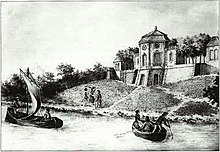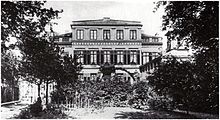Vinea Domini
The Vinea Domini ( Latin for "Lord's Vineyard") was a baroque pleasure palace ( French maison de plaisance ) built in the 1720s in a newly created wine-growing area on Bonn's banks of the Rhine, between the Old Customs and Second Fährgasse.
history
Urban planning and architectural history background
At the end of the 17th century, the French Sun King set a high point in classicist-baroque palace architecture with his Palace of Versailles . Following him, the European rulers also began to build magnificent baroque castles. Electors such as Clemens August von Cologne also built new residences: in Bonn with the magnificent ensemble Electoral Palace , Poppelsdorf Palace , the Herzogsfreude hunting lodge and the octagonal solitaire “vantage point” ( point de vue ) Vinea Domini . In 1745 the electoral palace was extended towards the Rhine with a gallery . There are two gates in this extension: the Stockentor and the Koblenzer Tor , through which the former state road from Kurköln to Kurmainz ran in a straight line (today Adenauerallee as part of Bundesstraße 9 ).
Vinea Domini
The shell of the Vinea Domini was completed in 1721/22 under Elector Joseph Clemens according to a design by the French architect Guillaume d'Hauberat . After Clemens' death, the castle passed into the possession of the Arch Brotherhood of St. Michael , who ceded it to the subsequent Elector Clemens August as a venue for an annual interest in 1725. In 1728 the installation of a retractable table designed by Johann Conrad Schlaun completed the Vinea Domini. Its surroundings were probably not redesigned to their final form until the 1740s. The castle was built at a point that, following the example of the strict symmetry of the building with central eye and vanishing points , from the market square past the baroque town hall built by the elector in 1738 , aligned along Stockenstrasse, through the Stockentor, then in extension - while maintaining the angle - through the Hofgarten to the intersection with the Rhine. Within the baroque city, the Vinea Domini functioned as the first focal point for travelers downstream on the Rhine, introducing the Electoral Palace. A vineyard landscape was laid out from the Altes Zoll to the Second Fährgasse: “The Lord's Vineyard” and the small building placed in the middle. In this way the biblical parable of the workers in the vineyard (Matthew 20), according to which the Lord takes the workers from the market place to work in the vineyard, was implemented.
The building was a centric, octagonal solitaire , which rose from an elongated basement level parallel to the Rhine on the left and right . In the middle of the polygon was a dining room with a "table deck you". At the retractable round table - at the invitation of the elector - larger groups of dignitaries, aristocrats and clergy gathered at festive receptions to enjoy the views of the Rhine, the Siebengebirge, the Godesburg , the Venusberg , the Kreuzberg , the Poppelsdorf Castle during the feasts and enjoy the Residenzschloss.
“Godesberg July 16, 1793. We left here yesterday afternoon at three o'clock, and after a quarter to four we were already at the Vinea Domini castle, which is only a shotgun away from the city and takes its name from a beautiful vineyard nearby Has. We looked at this little fairy castle, which is very cute. It is an octagon and has a spacious hall in the middle, in the floor of which a round table is hidden, which can be lowered into the kitchen by means of a winch and brought up again without annoying the diners. There are two small outbuildings for officers and supervisors, everything is covered with chestnut trees to provide shade and at the front you have a beautiful view of the Rhine flowing by ... "
In the course of the secularization on the Left Bank of the Rhine in 1802, the Vinea Domini fell to the French state, which sold it in 1803/04. It then served as an inn for a wine tavern and as an apartment. In November 1813 Cossacks attacked the castle. In Prussian times (from 1815) the Vinea Domini continued to exist as an excursion restaurant and attraction. Tourists and Rhine romantics raved about the feudal gem: "Café Lord's Vineyard". After viticulture had withdrawn from the areas close to the Rhine, including the Vinea Domini, to the slopes - as can be seen from statistics from 1843 - the plant was run down and was considered a relic by the system-critical students (mostly students of Friedrich Christoph Dahlmann ) from absolutist feudal times. The castle therefore no longer survived the events of the Vormärz (before 1848).
The city of Bonn had drawn up a development plan to develop and parcel out the banks of the Rhine . The university grew, and with it the demand for building land for academic staff. Wealthy citizens, privateers and the nobility also settled here in newly built villas. The ruins of the Vinea Domini and the adjacent parcels were sold, the central and southern side building opened in 1836 in a villa owned by Baron von Lorch - the "Villa Vinea Domini" (Coblenzerstraße 43), and the northern tower (pavilion) was rebuilt and served as the garden hall of the residential building of the district administrator of Sandt (Coblenzerstraße 41). The owner von Lorch had the villa rebuilt and extended according to plans by the Cologne cathedral builder Ernst Friedrich Zwirner . Princess Elisabeth zu Wied was one of the first guests to stay in the property for three years (1850–1853). Then it was the residence of the natural scientist Hermann von Helmholtz, who worked as a professor at Bonn University from 1855 to 1858 . In 1868 the villa was sold to the cloth merchant Siegfried Adolph Liebert. One of his six sons, the painter Edwin Mackinnon Liebert , spent his youth here. After the various renovations, only the vault in the basement remained of the former vineyard castle at the end of the 19th century.
After 1945
The Villa Vinea Domini fell victim to the bombing attacks at the end of the Second World War and remained part of the rubble landscape on the banks of the Rhine in Bonn. The preserved vault in the basement was torn down in 1951. In 1952, the state of North Rhine-Westphalia bought the site in order to open the new extension (Rhine wing with break hall) for the state Beethoven grammar school on the southern part in 1955 , and in 1960 to the north, then to build on the Bonn University and State Library . Since 1983 there has been an association of teachers and students of the Beethoven-Gymnasium, "Vinea Domini Archigymnasii Bonnensis", which cultivates a vineyard in the Rheinaue .
literature
- Gisbert Knopp , Klaus Thiel, Christina Notarius: The vineyard castle "Vinea Domini" in Bonn. An attempt at reconstruction. In: Landschaftsverband Rheinland , Rheinisches Amt für Denkmalpflege (Ed.): Yearbook of the Rhenish Preservation of Monuments. Volume 34, Rheinland-Verlag- und Betriebsgesellschaft, Pulheim 1992, ISBN 3-7927-1215-6 , pp. 25-36. [not yet evaluated for this article]
- Theodor A. Henseler: The electoral pleasure palace "Vinea Domini" . In: Bonner Heimat- und Geschichtsverein, Stadtarchiv Bonn (ed.): Bonner Geschichtsblätter. Yearbook of the Bonner Heimat- und Geschichtsverein , Volume 6, Bonn 1952, ISSN 0068-0052 , pp. 31–42. [not yet evaluated for this article]
- Paul Clemen : The art monuments of the city and the district of Bonn . L. Schwann, Düsseldorf 1905, p. 180 f. (= The Art Monuments of the Rhine Province , Volume 5, Section 3, p. 476 f.). (Unchanged reprint Verlag Schwann, Düsseldorf 1981, ISBN 3-590-32113-X ) ( Internet Archive )
Individual evidence
- ↑ bildindex.de , accessed on March 22, 2014.
- ↑ District archive Viersen, working group Niederrheinischer Kommunalarchivare: Kurköln, Land unter dem Krummstab . In: Publications of the state archives of North Rhine-Westphalia: Sources and research , Volume 22, self-published. d. NW State Archives, 1985, ISBN 978-3766694317 , p. 331.
- ^ Karl Gutzmer, Max Braubach: Chronik der Stadt Bonn , Chronik Verlag, 1988, p. 63.
- ^ A b Paul Clemen: The art monuments of the city and the district of Bonn
- ^ Annals of the Historical Association for the Lower Rhine, especially the old Archdiocese of Cologne, volumes 151-154 , Historical Association for the Lower Rhine, especially the old Archdiocese of Cologne, Historical Association for the Lower Rhine, especially the Old Archdiocese of Cologne, Historical Association for the Lower Rhine in particular the old Archdiocese of Cologne, L. Schwann, 1952, p. 135.
- ↑ http://www.siebengebirgsmuseum.de/images/pic/srr-2a.jpg
- ↑ Heijo Klein: Views from the Bonn bank of the Rhine . In: Bonner Heimat- und Geschichtsverein , Stadtarchiv Bonn (ed.): Bonner Geschichtsblätter. Yearbook of the Bonner Heimat- und Geschichtsverein , Volume 57/58, Bonn 2008, ISSN 0068-0052 , pp. 41–83 (here: p. 53).
- ↑ Letters from a traveler to his friend: About the stay at the Godesberger Gesundheitsbrunnen , Godesberg 1793, p. 68 f. ( Online Google Books )
- ^ Rheinische Geschichtsblätter, Volume 8 , Hanstein, 1907, p. 123.
- ^ Elector Clemens August: sovereign and patron of the 18th century , DuMont Schauberg, 1961, p. 220.
- ↑ Edith Ennen, Dietrich Höroldt: Small history of the city of Bonn . In: Bonner Geschichtsblätter , Volume 20, Stollfuss, 1968, p. 161.
- ↑ Handbook for Travelers, London, 1838, 2nd Edit / p. 255
- ↑ Dr. A. Ernst: Medical Topography and Statistics of the City of Bonn 1843 , Volume II, p. 41
- ↑ a b Olga Sonntag : Villas on the banks of the Rhine in Bonn: 1819–1914 , Bouvier Verlag, Bonn 1998, ISBN 3-416-02618-7 , Volume 1. (also dissertation University of Bonn, 1994)
- ^ Felix Hauptmann (Ed.): Bonner Archiv, Volumes 1-5 , 1890, p. 8.
- ^ Research center Carmen Sylva Princely Wiedisches Archiv Neuwied
- ^ Information board at Beethoven-Gymnasium, Wikimedia Commons
- ↑ a b War fates of German architecture. Loss - damage - reconstruction. Documentation for the territory of the Federal Republic of Germany. Volume 1: Nord , Karl Wachholtz Verlag, Neumünster 1988, ISBN 3-529-02685-9 , p. 385.
- ↑ Bilderbuch-bonn.de/Fotos/zentrum_vinea_domini_weinberg_beethoven_gymnasium_im_ Background_plan_b_wein_schule_weinanbau_428195
- ↑ GA-bonn.de/lokales/bonn/wein from the rheinaue-article 28648.html & i = o


